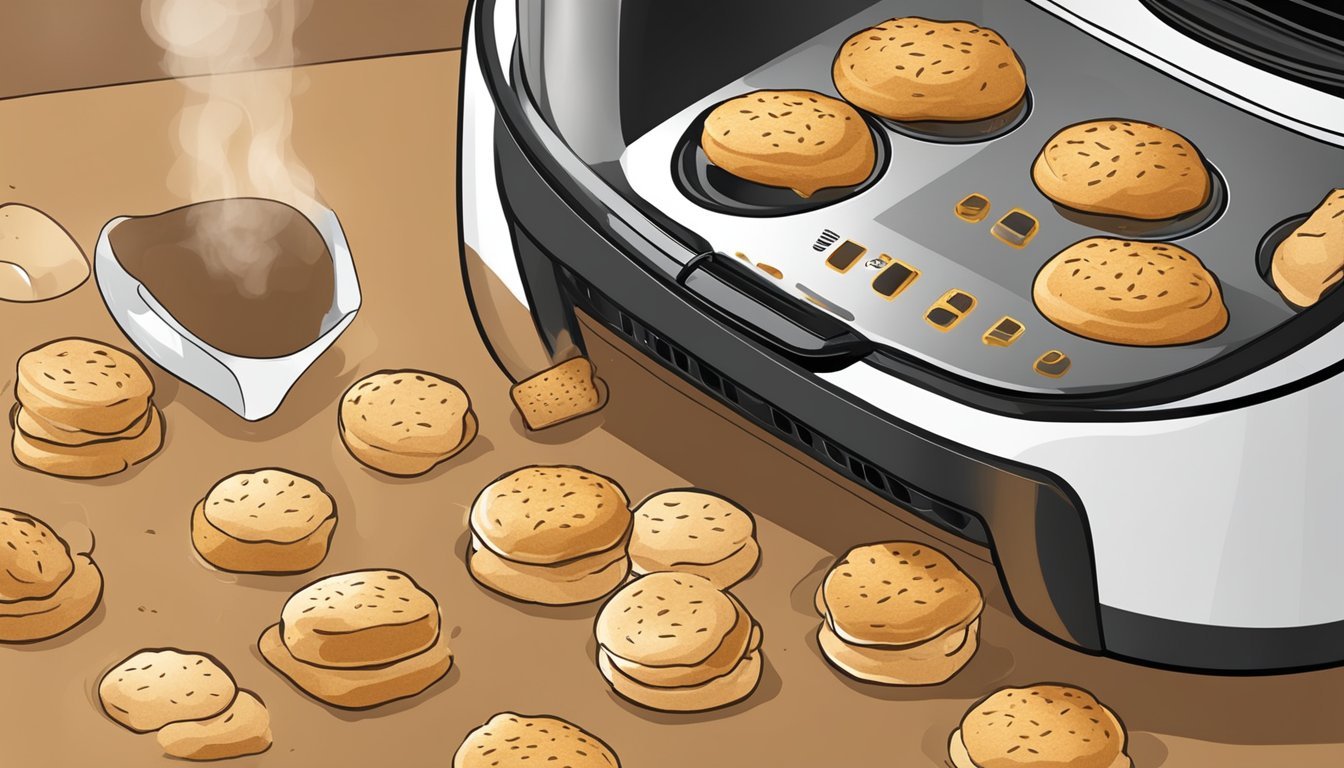Air Fryer Biscuits
A Quick Bread Option for Easy Snacking
Air fryer biscuits emerge as a revolutionary twist on the classic comfort food, offering the promise of quick preparation and delightful results. In the ever-evolving world of kitchen gadgets, the air fryer stands out for its efficiency and versatility, making it a favorite among those who seek to enjoy their favorite dishes with minimal fuss and healthier outcomes. Biscuits, with their flaky layers and buttery warmth, are transformed in the air fryer into a delicious treat that can be conjured up in mere minutes, unveiling a quick bread option that beckons home cooks of all skill levels.
The method for crafting air fryer biscuits is disarmingly simple, ensuring that even novices in the kitchen can achieve bakery-quality results. Recipes typically require a handful of standard ingredients and follow an easy-to-grasp formula: blend the dry ingredients, incorporate the fat, and gently mix in the wet components to form a malleable dough. This process, paired with the air fryer's consistent heat circulation, guarantees that each biscuit develops a golden exterior and a soft, airy center. The air fryer not only accelerates the cooking process significantly compared to traditional oven baking but also reduces the added fats used, aligning the creation of these quick breads with a more health-conscious approach to comfort food.
Essential Ingredients for Air Fryer Biscuits
Crafting the perfect air fryer biscuits relies on a combination of quality ingredients that work together to create a delicate texture and rich flavor. The selection of flour, the type of fats used, appropriate leavening agents, and the right choice of liquids are pivotal for successful biscuit-making.
Choosing the Right Flour
The base of any biscuit recipe is flour. All-purpose flour is preferred due to its balanced protein content, which is essential for forming a tender crumb without making the biscuit too tough. It's important to measure flour correctly to avoid a dense biscuit. Users may sift the flour to aerate it, which can contribute to a lighter texture.
The Role of Fats in Biscuit Texture
Fats, particularly butter, are crucial for flaky, rich biscuits. The choice between unsalted butter and salted butter impacts the final taste, with unsalted butter allowing for precise control of the biscuit's saltiness. Cold butter is often recommended because as it melts in the baking process, it creates steam that contributes to a flaky texture. Additionally, saturated fat in butter helps in maintaining a tender structure.
Leavening Agents for the Perfect Rise
Leavening agents such as baking powder and baking soda are indispensable for biscuits to rise. Baking powder, which contains both acid and base, is commonly used in biscuit recipes to ensure a good lift. When buttermilk is used, baking soda can also be utilized since buttermilk's acidity activates it, producing carbon dioxide and contributing to leavening.
Liquids for Dough Formation
Liquids are necessary to bring the dough together. Options include whole milk, buttermilk, and sometimes plain milk. Buttermilk adds a slight tang and reacts with the leavening agents to help the biscuits rise. Whole milk contributes to a richer flavor and tender texture. Liquids should be cold to prevent premature melting of fat, allowing for proper dough formation without the need to knead excessively, which can lead to tough biscuits.
Step-by-Step Biscuit Preparation
Preparing biscuits in an air fryer simplifies the baking process, offering a quick and mess-free method to achieve delicious, flaky biscuits with simple ingredients. Follow these specific steps to ensure the best results.
Mixing the Dry Ingredients
In a mixing bowl, one should start by whisking together the fundamental dry ingredients: flour, baking powder, and if required, a pinch of salt and sugar. These components provide structure and leavening, ensuring the biscuits rise appropriately.
Incorporating Cold Butter for Flakiness
For that sought-after flakiness, grate or cut in cold butter into the dry mix. This can be done using a pastry cutter or a fork. The key is to work quickly and efficiently to keep the butter firm, which contributes to creating those flaky layers.
Adding Liquids and Forming the Dough
Once the dry ingredients and butter are combined, gradually introduce milk or buttermilk. Stir gently, just until the dough comes together to avoid over-mixing. Overworked dough can lead to tough biscuits. Then, on a lightly floured surface, one should knead the dough minimally, enough to bring it all together.
Cutting the Biscuits
Roll out the dough to about 1 inch thickness and use a biscuit cutter to shape the biscuits. For homemade biscuits, spacing is essential; in an air fryer basket, arrange them with enough distance to allow for expansion and even cooking.
Air Fryer Cooking Techniques
When baking biscuits in an air fryer, utilizing proper techniques ensures a crisp, golden finish. This section examines how to effectively preheat the air fryer, arrange biscuits for optimal cooking, and determine the appropriate cooking times for perfect results.
Preheating the Air Fryer
Preheating an air fryer is a critical step that should not be skipped when baking biscuits. A preheated air fryer helps achieve a more consistent cooking temperature, leading to evenly baked biscuits with a desirable golden color. Users should follow their specific air fryer's instructions, but generally, preheating to a temperature between 325°F (162°C) and 400°F (204°C) is recommended depending on the recipe.
Arranging Biscuits in the Air Fryer
How biscuits are placed in the air fryer basket directly influences baking results. For optimal air circulation and crispness, biscuits should be arranged in a single layer with space between them. If the biscuits are meant to be soft, touching each other is acceptable. Using parchment paper can prevent sticking and ease cleanup, but it's optional depending on the non-stick quality of the air fryer basket.
Single layer: Essential for a crisp exterior.
Space between biscuits: Encourages even cooking.
Parchment paper: Optional for non-stick purposes.
Determining Cooking Times
Cooking times can vary widely depending on the air fryer model and the specific biscuit recipe used. A common temperature for air frying biscuits is around 330°F (165°C), with a cooking time range of 9 to 12 minutes. It's important to monitor the biscuits towards the end of cooking to prevent over-baking, flipping them halfway through if crispness on both sides is desired.
Typical temperature: 330°F (165°C)
Average cooking time: 9 to 12 minutes
Flipping: Recommended for even browning
Consistently checking for a golden color and using a toothpick to test for doneness can help achieve the perfect bake. Adjustments to cooking times may be necessary based on the air fryer's performance and the chosen recipe's requirements.
Serving and Pairing
Air Fryer Biscuits offer a delicious and quick option for breakfast or as a side dish. They can be customized in a variety of ways to cater to different tastes, whether served with classic toppings or transformed into hearty sandwiches.
Accompaniments for Biscuits
One can serve air fryer biscuits with a range of toppings and sides to enhance their flavor. A dollop of butter allows its rich taste to melt into the warm biscuits. Adding jam provides a sweet contrast to the savory biscuits, creating a perfect blend of flavors. For a more indulgent option, one might cover them in gravy, a staple in traditional Southern cuisine, turning them into a satisfying component of a family meal. To elevate the experience, pair the biscuits with:
Soup: Serve as a side to creamy or broth-based soups.
Family Breakfast: Accompany biscuits with scrambled eggs and bacon for a complete meal.
Transforming Biscuits into Breakfast Sandwiches
Biscuits are versatile and can be converted into breakfast sandwiches, a fulfilling start to the day that is easy to customize. Split a biscuit in half and layer with:
A seasoned egg: fried or scrambled.
A slice of cheese: cheddar, Swiss, or American for a creamy touch.
A portion of meat: such as crispy bacon, sausage, or ham.
These ingredients come together to create a convenient and hearty breakfast sandwich that is ideal for on-the-go mornings or a leisurely family brunch.
Storing and Reheating
Proper storage methods ensure that leftover biscuits retain their quality, while effective reheating techniques restore their freshness and texture.
Best Practices for Storage
When storing biscuits, keeping them in an airtight container is crucial to maintaining freshness. For short-term storage, biscuits should be placed in an airtight container or wrapped securely in plastic wrap or aluminum foil and kept at room temperature for up to two days. They can be refrigerated for up to one week if stored properly in a sealed container.
For those intending to keep biscuits longer, freezing is an excellent option. To freeze biscuits:
Allow them to cool completely after baking to prevent condensation.
Wrap them individually in plastic wrap.
Place the wrapped biscuits in a freezer bag or airtight container.
Use parchment paper to separate layers if stacking is necessary.
Biscuits can be stored in the freezer for up to three months.
Tips for Reheating Leftovers
Reheating biscuits in an air fryer effectively restores their texture and warmth without drying them out. To reheat refrigerated or room-temperature biscuits:
Preheat the air fryer to 350°F (175°C).
Arrange biscuits in a single layer in the basket, ensuring there's space between them for even heat distribution.
Heat for 3-4 minutes, checking halfway through to prevent burning.
For frozen biscuits, there's no need to thaw. Simply extend the reheating time slightly:
Preheat the air fryer to 340°F (170°C).
Place the frozen biscuits in the air fryer, spacing them out.
Reheat for 6-8 minutes or until thoroughly warmed.
Nutritional Information and Health Considerations
When it comes to preparing biscuits in an air fryer, a primary consideration is the nutritional content of the finished product. Air-fried biscuits typically contain carbohydrates, which serve as the body’s main energy source. The exact amount of carbohydrates will vary based on the recipe and portion size.
Proteins and fats are also present in air fryer biscuits, which are important for body functions and satiety. Fats should be consumed in moderation, and the use of butter in the recipe contributes to both saturated fat and cholesterol content, which can be a concern for heart health.
Nutrient Consideration Saturated Fat Monitor intake; could impact cardiovascular health Cholesterol May be present; caution for those monitoring levels Sodium Can be high; moderation is key Fiber Generally low; varies with flour type
The biscuits made in an air fryer might be a source of calcium and iron if the flour used is fortified. They are generally minimal in trans fat, especially if prepared from scratch with natural ingredients. As for sodium, recipes can vary, and too much can lead to health issues, so it is advisable to keep an eye on salt and baking powder/soda quantities.
Air frying could potentially offer a lower-calorie option compared to traditional frying due to lower fat usage. However, this is highly dependent on the recipe and the amount of dough used to form each biscuit. Additionally, substitutions like low-fat milk can lower calorie and fat content.
Lastly, minimal amounts of potassium, vitamin A, and fiber may be present, contributing marginally to the daily recommended intake.
In conclusion, those consuming air fryer biscuits should be mindful of the ingredients used and consider them in the context of their overall dietary needs and restrictions.
Recipe Variations and Creative Add-Ins
Exploring the realm of biscuit variations breathes new life into the classic comfort food. By incorporating different mix-ins or tweaking the recipe base, one can easily customize biscuits to suit any palate or dietary preference.
Flavored Biscuit Options
Infusing biscuits with flavor transforms them from simple to spectacular. One can begin with a basic biscuit recipe and add ingredients such as cheddar, garlic, or parmesan cheese to create a savory option. For a subtly sweet version, mixing in honey or brushing the biscuits with it prior to baking adds a delightful touch.
Savory Mix-Ins:
Cheddar Cheese: 1/2 cup grated cheddar mixed into the dough.
Garlic Powder: 1 teaspoon garlic powder for a garlic twist.
Parmesan: Sprinkle grated parmesan on top before baking.
Sweet Enhancements:
Honey: 2 tablespoons of honey mixed into the dough or brushed on top before serving.
Healthy Alternatives
For those looking to increase the nutritional content of their homemade biscuits or create lighter fluffy biscuits, substitutions can be quite effective. Swapping out regular milk for buttermilk can enhance the tenderness and flavor. Using olive oil instead of butter provides a heart-healthy fat alternative. To increase fiber, one can partially replace all-purpose flour with whole wheat flour.
Health-Conscious Substitutions:
Buttermilk Biscuits: Replace regular milk with buttermilk for fluffier biscuits.
Olive Oil: Use olive oil in place of butter for a healthier fat option.
Fiber Boost:
Whole Wheat Flour: Substitute half of the all-purpose flour with whole wheat flour to increase fiber content.
Through these variations and add-ins, whether one uses homemade or Pillsbury Grands biscuits or opts for canned biscuits, the possibilities for flavor and healthful adjustments are numerous and can cater to a gamut of tastes and dietary needs.
FAQs and Troubleshooting
Common Questions About Air Fryer Biscuits
Why are my biscuits not fluffy? Ensure the butter is cold and cut into small pieces before mixing. Overworking the dough can result in tough biscuits rather than tender ones.
Can I use lemon juice in the recipe? Yes, a small amount of lemon juice can act as a leavening agent when mixed with baking soda.
Is this a quick and easy recipe? Definitely! Air fryer biscuits are a quick and straightforward option, often requiring just a few simple ingredients and minimal preparation time.
Troubleshooting Tips
Biscuits are undercooked: Increase cooking time by 1-2 minutes, checking frequently to avoid over-browning.
Biscuits are too dry: Add a touch more milk to the dough before cooking to achieve a moister texture.
The dough is too sticky: Gradually mix in a bit more flour to reach the right consistency.
Not rising properly: Check that your baking powder is fresh and properly measured.
Ensuring Perfect Biscuits Every Time
Mixing Technique: Mix the ingredients in a mixing bowl just until combined for the best texture; avoid over-mixing.
Ingredient Temperature: Use cold butter and milk, as this helps create steam during cooking that aids in rising.
Size and Spacing: If the air fryer isn't cooking biscuits evenly, they might need more space. The biscuits should barely touch when raw.
Testing Doneness: Biscuits should be golden brown and firm on the outside. If you're unsure, use a toothpick to test; it should come out clean.
Conclusion
Air fryer biscuits offer a swift and energy-efficient alternative to traditional oven baking. These biscuits can be prepared with minimal ingredients, often requiring just flour, butter, and milk. Using an air fryer, one can achieve a golden brown and crispy exterior with a soft, flaky interior in a fraction of the time it takes in a standard oven.
Key Points to Remember:
Preheating the air fryer is crucial for an even bake.
Ingredients should be simple: flour, butter, and milk or buttermilk are the foundation of most recipes.
Overmixing the dough can lead to tough biscuits.
Biscuits can be placed close together in the air fryer to promote even cooking.
Cooking times vary, but 8-12 minutes at 325°F to 400°F is standard.
Air fryer technology enables rapid air circulation, which cooks the biscuits efficiently. It's important to note that air fryers come in different sizes, so the number of biscuits that fit will vary. Smaller batches are recommended to ensure consistent results.
Bakers appreciate the lower energy consumption of air fryers compared to ovens, making it a more sustainable choice for small batches. Individuals with dietary restrictions can adapt recipes by substituting traditional ingredients with gluten-free flour or dairy alternatives without compromising the convenience air fryers provide.
In short, air fryer biscuits are a practical quick bread option for those looking for a quick, less energy-intensive baking method without sacrificing quality. The outcome satisfies anyone's craving for a homemade, comforting treat.








